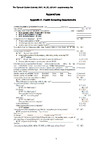Exploring the minimum number of trials needed to accurately detect concealed information using EEG
| dc.contributor.author | Graham, R. | |
| dc.date.accessioned | 2021-12-24T18:06:01Z | |
| dc.date.available | 2021-12-24T18:06:01Z | |
| dc.date.issued | 2021 | |
| dc.identifier.citation |
Graham, R. (2021) 'Exploring the minimum number of trials needed to accurately detect concealed information using EEG', The Plymouth Student Scientist, 14(2), pp. 532-547. | en_US |
| dc.identifier.uri | http://hdl.handle.net/10026.1/18514 | |
| dc.description.abstract |
Deception can have serious consequences, therefore detection methods such as the Electroencephalogram (EEG) are vital. However, they can be perceived as time-consuming thus causing limited usage. The purpose of this study was to discover the minimum number of trials needed to accurately detect deception. It was hypothesised that accuracy would increase with number of trials (due to reduced effects of noise) but would then fall (due to subject’s fatigue). Due to the Coronavirus, this study was restricted to 9 participants within our ‘Lab Bubble’ of third-year Psychology students at the University of Plymouth. A Concealed Information Test (CIT) was conducted, using target stimuli (a random date requiring a button press response), probe stimuli (subjects’ date of birth to conceal), and irrelevant stimuli (random dates). Participants wore a wireless EEG cap with 7 electrodes which recorded their brain activity and P300 responses. The results revealed that participants consistently produced higher amplitude responses to probe than to irrelevant stimuli, highlighting the accuracy of this method. At 10 trials deception was hard to detect, as noise caused variability in probe stimuli P300 responses. The accuracy dramatically increased until 40 trials and peaked at 60 trials. The minimum number of trials recommended was 50 as it was highly accurate and less time-consuming. Demonstrating the efficiency of the EEG (by discovering the minimum number of trials required) may encourage wider use. This has salient implications in law enforcement and security clearances, as it has the potential to prevent crimes, thus protecting both individuals and society. | en_US |
| dc.language.iso | en | en_US |
| dc.publisher | University of Plymouth | en_US |
| dc.rights | Attribution 3.0 United States | * |
| dc.rights.uri | http://creativecommons.org/licenses/by/3.0/us/ | * |
| dc.subject | EEG | en_US |
| dc.subject | deception | en_US |
| dc.subject | neuroscience | en_US |
| dc.subject | brainwaves | en_US |
| dc.subject | P300 | en_US |
| dc.title | Exploring the minimum number of trials needed to accurately detect concealed information using EEG | en_US |
| dc.type | Article | en_US |
| plymouth.issue | 2 | |
| plymouth.volume | 14 | |
| plymouth.journal | The Plymouth Student Scientist |




